An Introduction to American Law

本文是 https://www.coursera.org/programs/career-training-for-nevadans-k7yhc/learn/american-law 这门课的学习笔记。
文章目录
Instructors
Anita Allen, Henry R. Silverman Professor of Law and Professor of Philosophy, Penn Law, University of Pennsylvania
Shyam Balganesh, Professor of Law, Penn Law, University of Pennsylvania
Stephen Morse, Ferdinand Wakeman Hubbell Professor of Law; Professor of Psychology and Law in Psychiatry; Associate Director, Center for Neuroscience & Society, Penn Law, University of Pennsylvania
Theodore Ruger, Dean and Bernard G. Segal Professor of Law, Penn Law, University of Pennsylvania
Tess Wilkinson-Ryan, Assistant Professor of Law and Psychology, Penn Law, University of Pennsylvania
Tobias Barrington Wolff, Professor of Law, Penn Law, University of Pennsylvania
Syllabus
Syllabus
This class requires a small amount of reading, a series of lectures, weekly quizzes, and a final exam. To complete the course, for each module you should:
- Read the key terms for each area of law. Some of the entries say “click here for more information” - you are encouraged to follow the links and get a more detailed description.
- Watch the series of lectures posted.
- Explore any of the supplemental readings that interest you.
- Take the quiz.
Module 1: Tort Law
To learn about Professor Allen’s work in privacy law click here.
Supplemental Reading
- “What is an intentional tort?”
- Tort law and personal injury cases
- Tort law and products liability cases
- Excerpt from Westlaw’s Black Letter Law Outline: Tort
Module 2: Contract Law
To learn more about Professor Wilkinson-Ryan and her thoughts on the psychology of contracts, click here.
Supplemental Reading
- “Contract Law: The Basics”
- “Contract Law 101”
- “Contract Law” (Encyclopedia Britannica)
- For more information, explore this website
- Excerpt from Westlaw’s Black Letter Law Outline: Contract
Module 3: Property Law
Professor Balganesh weighs in on a recent ruling here.
Supplemental Reading
- “Property Law” (Encyclopedia Britannica)
- “Property and Ownership” (a philosophical perspective)
- “U.S. Landlord-Tenant Law”
- Excerpt from Westlaw’s Black Letter Law Outline: Property
Module 4: Constitutional Law
To hear Professor Ruger talk more about the Affordable Care Act on CBS News click here.
Supplemental Reading
- The U.S. Constitution
- “History of the Constitution”
- “The Constitution of the United States: A History”
- [“Our Constitution”](http://www.annenbergclassroom.org/Files/Documents/Books/Our Constitution/COMPLETED_Our Constitution.pdf)
- Excerpt from Westlaw’s Black Letter Law Outline: Constitutional Law
Module 5: Criminal Law
Watch Professor Morse discuss neuroscience and the criminal justice system with Alan Alda here.
Supplemental Reading
- “Criminal Charges: How Cases Get Started”
- “Steps in a Criminal Case: From Arrest to Appeal”
- Excerpt from Westlaw’s Black Letter Law Outline: Criminal Law
Module 6: Civil Procedure
Professor Wolff writes about the Employment Non-Discrimination Act and discrimination in the workplace here.
Supplemental Reading
- “Lawsuit Chronology”
- “Civil Cases: The Basics”
- “How Class Action Lawsuits Work”
- The Federal Rules of Civil Procedure (skim only)
- Excerpt from Westlaw’s Black Letter Law Outline: Civil Procedure
Week 01: Tort Law
Tort law governs how people may sue each other civilly (as opposed to criminally) in order to receive compensation for harms or injuries other people caused them. In this module, Professor Allen will explore the goals of tort law through a historic case. She will address what makes tort law distinct and issues surrounding negligence and liability.
侵权法规定了人们如何通过民事诉讼(而非刑事诉讼)来获得对他人造成的伤害或损害的赔偿。在本单元中,Allen 教授将通过一个历史案例探讨侵权法的目标。她将讨论是什么使侵权法与众不同,以及围绕过失和责任的问题。
Key Tort Law Terms
Tort Law
A civil wrong which can be redressed by awarding damages. For more, click here: http://www.law.cornell.edu/wex/tort
Key Terms:
battery
The intentional causation of harmful or offensive contact with another’s person without that person’s consent. (http://www.law.cornell.edu/wex/battery) This is an example of an intentional tort.
comparative negligence
A tort rule for allocating damages when both parties are at least somewhat at fault. In a situation where both the plaintiff and the defendant were negligent, the jury allocates fault, usually as a percentage (for example, a jury might find that the plaintiff was 30% at fault and the defendant was 70% at fault). (http://www.law.cornell.edu/wex/comparative_negligence) This system has replaced the old rule of contributory negligence.
contributory negligence
A plaintiff was totally barred from recovery if they were in any way negligent in causing the accident, even if the negligence of the defendant was much more serious. (http://www.law.cornell.edu/wex/contributory_negligence) Today, the more common rule is c**omparative negligence.
damages
In tort law, a remedy in the form of monetary compensation to the harmed party. (http://www.law.cornell.edu/wex/damages)
fault
In civil law - negligence, want of care, an improper act or omission,injurious to another, and transpiring through negligence, rashness, or ignorance. (http://thelawdictionary.org/fault/)
intentional tort
A type of tort that can only result from an intentional act of the defendant (as opposed to a negligent one). (http://www.law.cornell.edu/wex/intentional_tort)
negligence
A failure to behave with the level of care that someone of ordinary prudence would have exercised under the same circumstances. The behavior usually consists of actions, but can also consist of omissions when there is some duty to act (e.g., a duty to help victims of one’s previous conduct). For more, click here: http://www.law.cornell.edu/wex/negligence
products liability
American law holds the manufacturers of consumer products strictly liable for injuries caused by manufacturing defects. For more, click here: http://www.law.cornell.edu/wex/products_liability.
punitive damages
Punitive damages are awarded in addition to actual damages in certain circumstances. Punitive damages are considered punishment and are awarded when the defendant’s behavior is found to be especially harmful, but are normally not awarded in the context of a breach of contract claim. (http://www.law.cornell.edu/wex/punitive_damages)
res ipsa loquitur
Latin for “the thing speaks for itself.” In tort, a principle that allows plaintiffs to meet their burden of proof with what is, in effect, circumstantial evidence. The plaintiff can create a rebuttable presumption of negligence by the defendant by proving that the harm would not ordinarily have occurred without negligence, that the object that caused the harm was under the defendant’s control, and that there are no other plausible explanations. (http://www.law.cornell.edu/wex/res_ipsa_loquitur)
strict liability
Rule providing that if you cause an injury by a deliberate act, even if you did not mean to cause injury and were careful, you are liable to compensate the injured party. For more, click here: http://www.law.cornell.edu/wex/strict_liability
Tort Law: Part 1
[MUSIC] Hello, my name is Anita Allen. I’m the Henry R. Silverman Professor of Law and Professor
of Philosophy at the University of Pennsylvania Law School where
I’ve taught for 17 years. I’m here today in the moot courtroom
of the law school to tell you about American tort law, what makes
it special, what makes it distinct. What is American tort law? To begin, I’d like to tell you
a story from the 19th century when an American tort law, distinct
from English tort law, first emerged.
So, two dogs broke out in a vicious fight. One dog was owned by Mr.
Brown, the other by Mr. Kendall. Concerned about the safety of the animals,
Kendall took a long stick, about four feet long, and began beating
the dogs, hoping they would separate. Brown stood behind Kendall,
observing his efforts. Unfortunately, an accident occurred. At one point, Kendall took a few
steps backward in the direction of Brown while continuing to swing the stick. He didn’t see just how
close he was to Brown. He inadvertently struck Brown in the eye,
causing severe injury. Like the unfortunate Mr.
Brown, people are injured every day. They’re injured in car collisions, while operating machinery,
at work, by medical procedures. They’re injured by pranks, by invasions
of privacy, in natural disasters, when ferries capsize,
in train, in air crashes, at sport, in fights, in war,
and in acts of terrorism.
The property that people
value is damaged too. Their animals can be poisoned,
their cars dented, their jewelry stolen, their bicycle
swiped, their homes burned down, their smart phones borrowed and
left out in the rain. Tort law is a response to
the problem of injuries like these.
Tort law allows someone injured,
like Mr. Brown, to seek monetary damages from someone
who causes an injury, like Mr. Kendall. Did Brown actually win money from Mr.
Kendall? More about that in just a few moments. But let me tell you something
more about tort law. American tort law is
part of our common law. It is typically distinguished
from other areas of common law, most notably from contract law,
which arises out of mutual agreements, from property law, which regulates
ownership, and criminal law, which penalizes wrongs
on behalf of the public.

We use the term tort action to refer
to a civil lawsuit based on a claim that someone has violated judge made rules
or closely related civil statutes that serve as precedent and authority for
adjudicating private disputes.
我们使用术语“侵权行为诉讼”来指基于某人违反了法官制定的规则或密切相关的民事法规而提起的民事诉讼,这些规则或法规是裁决私人纠纷的先例和权威。
As noted, tort actions usually seek
money to compensate for the harm done. Where injury is ongoing,
though, someone fed up with it might seek a court order to just enjoin
the action, enjoin the noises, the smells, the pollution, or other nuisances or
harms that are affecting them.
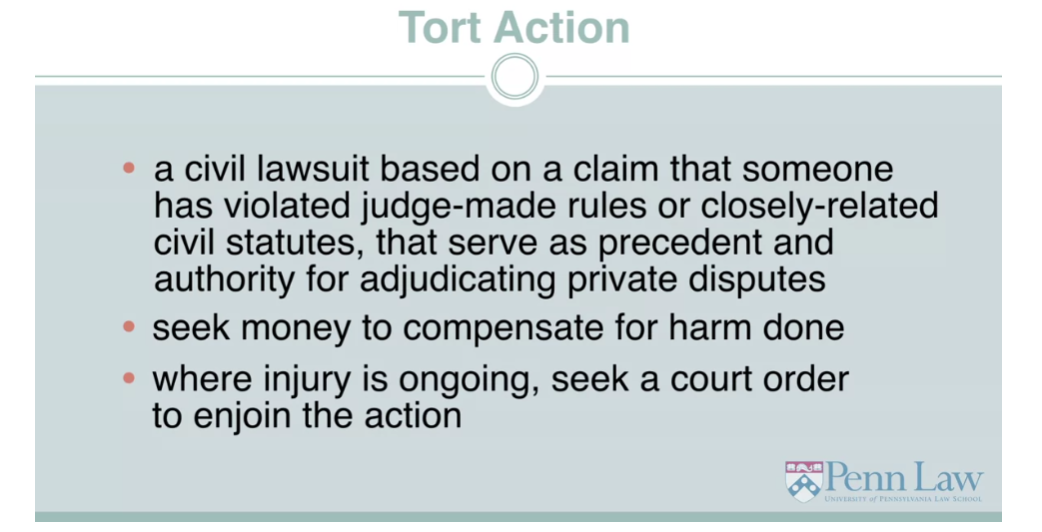
American tort law is embedded in
an adversary system of procedural justice. Each party hires their own lawyers and expert witnesses to persuade judge and
jury. The adversary system relies upon the use
of non-expert juries to adjudicate facts, and upon professional lawyers to bring and defend claims before professional
judges and to negotiate settlements.
Substantive tort law is
private law made by judges and modified from time to
time by state statutes. Tort law empowers victims of injury to
receive justice from those whom judges and juries consider responsible for
their injuries.
ChatGPT:
侵权法是民事法律领域的一个重要分支,主要涉及个人在未签订合同的情况下,因他人的不当行为导致的损害问题。它关注的是对他人权益的侵犯和损害,包括人身损害和财产损失,以及应对这些侵害行为采取的法律措施。侵权法规定了侵权行为的构成要件、受害者的赔偿权利、侵权责任的承担和免责条件等内容。侵权法的主要目的是保护个人的合法权益,维护社会的公平正义,促进社会的和谐稳定。
Substantive tort law is a branch of civil law that primarily deals with issues arising from harm caused by one person to another in the absence of a contract. It focuses on the infringement of individual rights and interests, including personal injury and property damage, as well as the legal remedies available for such infringements. Substantive tort law establishes the elements of tortious conduct, the rights of the victims to compensation, the liability and immunity conditions, among other things. Its main purpose is to protect individuals’ legal rights, uphold fairness and justice in society, and promote social harmony and stability.
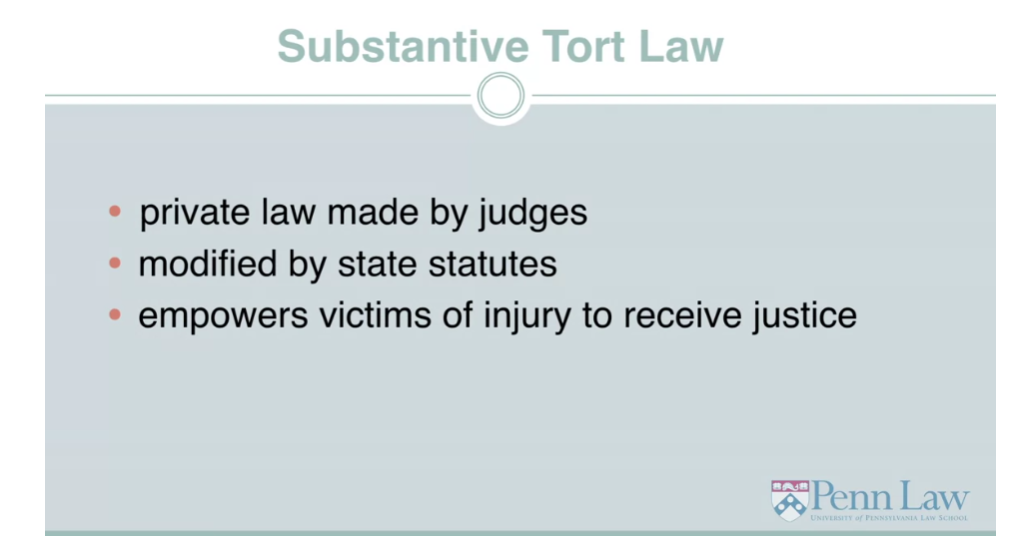
But what kind of justice? The justice of money? It’s often said that the main purpose
of tort law is to compensate victims of injury to achieve what some Western
philosophers call corrective justice. Corrective justice is a justice
that seeks to redress wrongs by placing the injured person
back in the situation he or she was before they were injured,
the status quo ante, as we say in Latin.
You can’t give a man who’s lost an eye a
new eye, but you can give him enough money to buy a fake eye, a prosthetic eye, visit
his doctor, replace lost wages, and afford a lifestyle similar to the one he enjoyed
prior to the injury when he had two eyes.
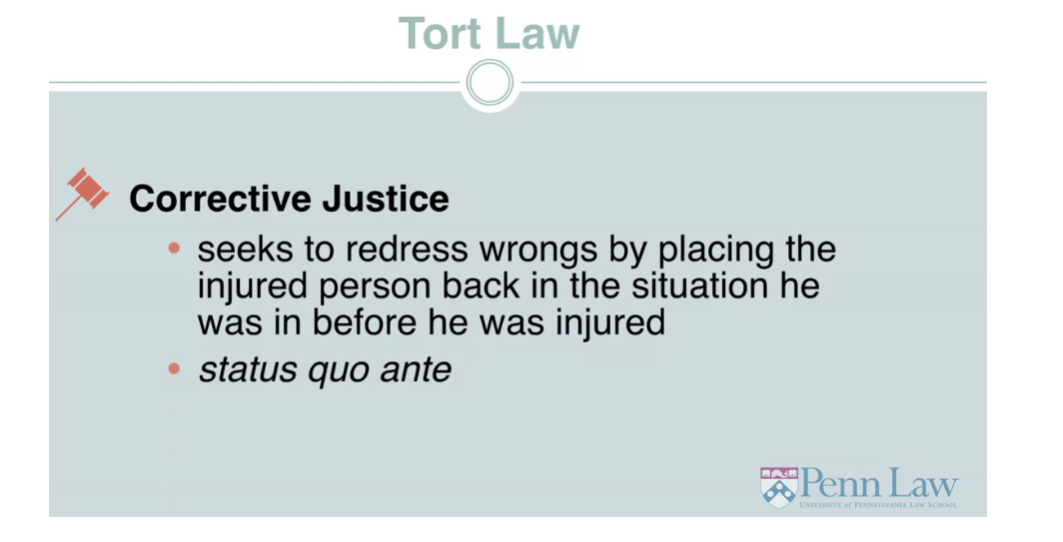
Tort law is not just
about corrective justice. Judges have recognized other
aims of tort liability. These variously include
deterring careless and aggressive behavior,
punishing recklessness and malice, encouraging insurance, and forcing
businesses to internalize their costs.
侵权法不仅仅是矫正正义。法官们已经认识到侵权责任的其他目的。这些措施包括遏制粗心和攻击性行为,惩罚鲁莽和恶意行为,鼓励保险,并迫使企业将成本内化。
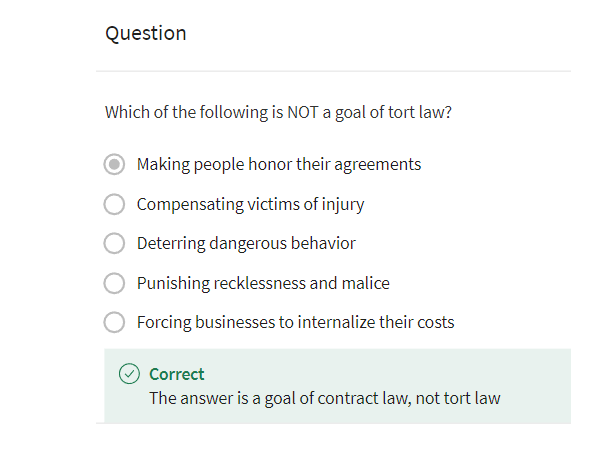
As law students quickly discover,
American tort law consists of a very, very large number of judge made rules and
principles. The rules differ slightly
from state to state, so American tort law is really 50
different sets of tort law. But there is much commonality
in state common law. The law doesn’t change much from New York,
for example, to California. Some of the rules and principles that
comprise tort law are centuries old, inherited from English common law. Some are only decades old. Some even newer. Tort law changes. Judges can change the rules.
One of the distinctive features of the
rules and principles of U.S. tort law is a decided preference for imposing
liability only where someone is at fault.
美国侵权法规则和原则的一个显著特点是,明确倾向于仅在某人有过错的情况下才追究责任。
We blame. But there are numerous
pragmatic exceptions.
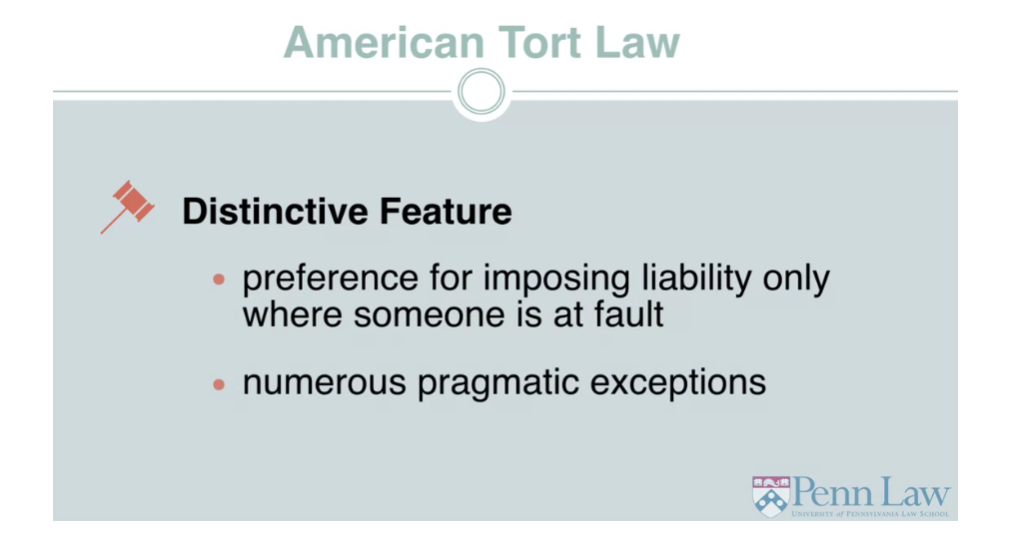
With respect to some classes of injury,
courts think liability is so important for policy reasons, for the sake of social
goals like reducing the frequency and severity of accidents, for example, that
they assign responsibility without fault.
American law recognizes
three main categories of tort liability corresponding to
three broad sources of injury. One, injuries stemming
from intentional acts. Two, injuries stemming
from negligent acts. And three, injuries stemming
from dangerous activities or defective consumer products.
危险活动或有缺陷的消费品造成的伤害。
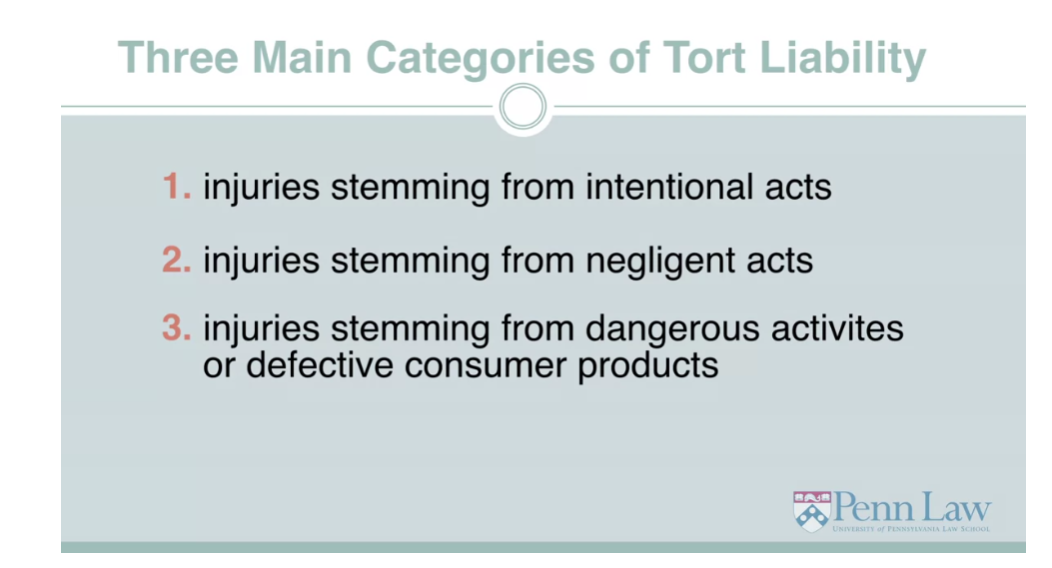
I have taught tort law in
the United States for more than 25 years. What keeps me interested is the stories
of how people get hurt, and whether the rules and principles of tort law can
be brought to bear to make things better. Like most professors, I teach tort law
mainly by asking students to read and discuss the stories
that comprise case law. Case law is the body of reasoned
opinion judges write to explain their decisions in the individual
cases brought before them. Judges do their best, but
they don’t always get the rules right and don’t always make sense. Their published opinions become
the authorities, though, upon which we rely to guide our
behavior and resolve our disputes. We try to be critical but also respectful. Our judges are storytellers, and learning common law torts is learning
the stories and the significance of the stories that judges tell about
our personal and public calamities. [MUSIC]
Tort Law: Part 2
[MUSIC] Now back to the story of the dogfight. First, the dogs locked in battle. Then their owners took up
a battle of their own. Mr. Brown wanted money as justice from Mr.
Kendall. Kendall didn’t think Brown deserved it. Brown brought a tort action against
Kendall in a Massachusetts state court, hoping to force Kendall to pay. Now, Brown was the plaintiff and
Kendall a defendant in an adversarial court case that American legal history
came to know as Brown versus Kendall. We can speculate that Kendall was very
unhappy about getting sued when he intended no harm to Brown. No one really likes getting sued. But why?
Well, first of all, lawsuits can
damage one’s reputation as a good and careful person, good and
careful employer or business. Second, lawsuits are time-consuming. They can drag on for years. You might be injured in 2014 and
not see your case resolved until 2020. Mr. Kendall died before Brown’s
case against him was resolved, and the case against him had to go on against
his estate represented by his wife. Third, sometimes it seems
litigious people sue just for revenge, to annoy, or to get easy money
through an out-of-court settlement. Sometimes with deep pockets,
such as wealthy defendants or an insurance company. Experts disagree about
the percentage of U.S. lawsuits that are frivolous and
unjustified.
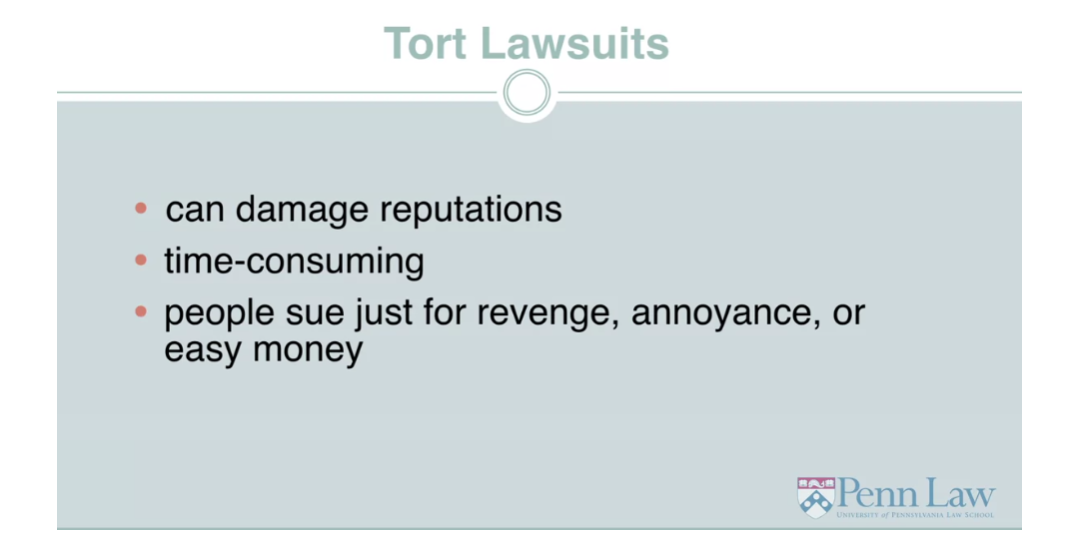
But I tend to think there are fewer
lawsuits than would be warranted by the facts. There’d be more lawsuits, but
people don’t want to be hassled. They don’t have access to lawyers, and
they can’t manage the distractions.
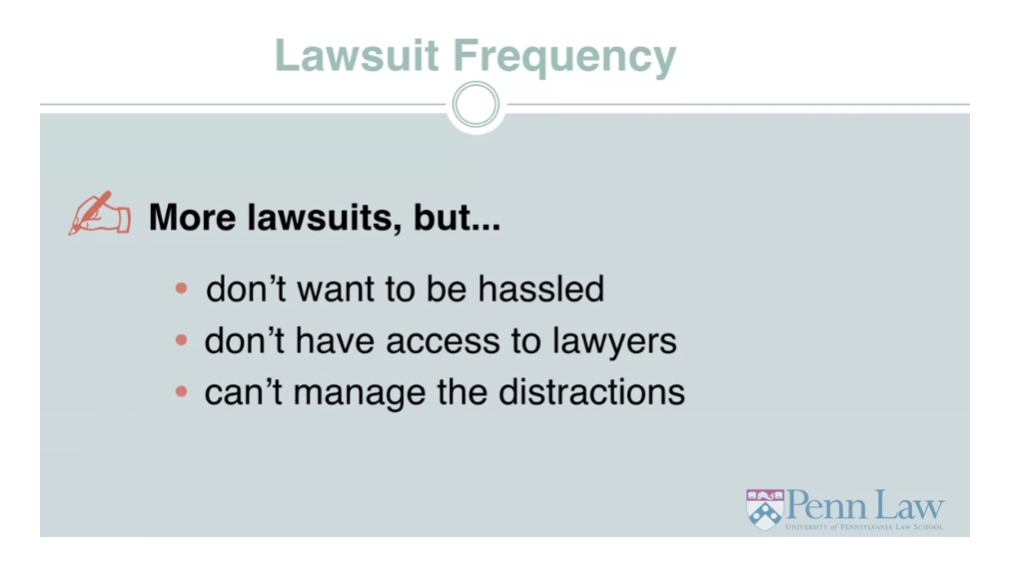
We can speculate that Mr. Brown probably
needed the money he was suing to get. Most Americans who suffer serious
accidental injury are not wealthy and have a practical need for
money to pay medical expenses or to replace lost earnings
resulting from their injuries. In the U.S., we’ve never had a national
health insurance plan that provides free healthcare for ordinary people, and
no job guarantees for injured workers. We do have something called Social
Security Disability programs that didn’t exist in Mr. Brown’s day to help
permanently disabled people. But the amounts that people get from
the state are very small compared to what they might earn in a lawsuit.
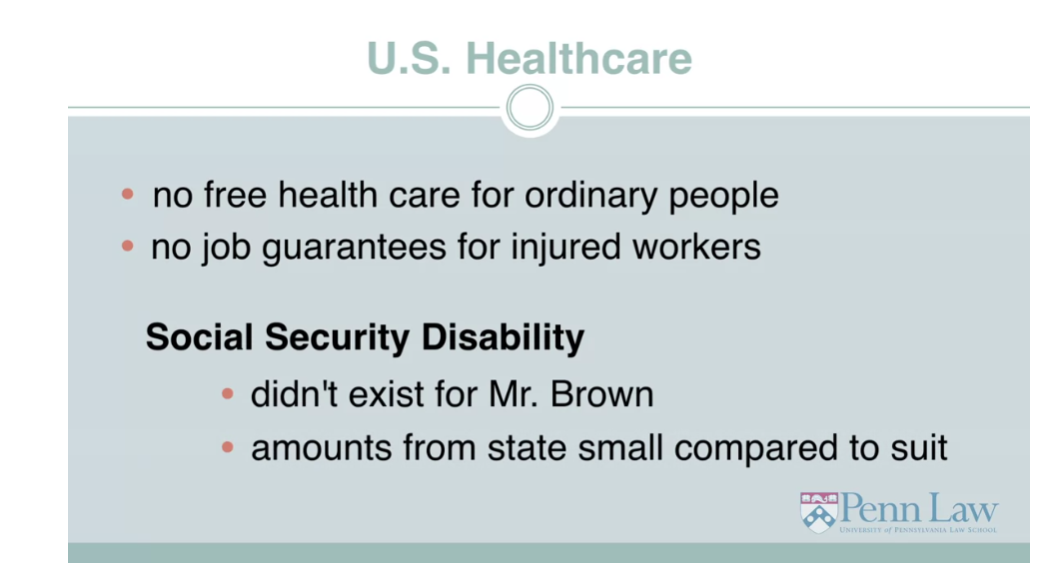
But bringing and
defending lawsuits is expensive. You have to hire a lawyer. The America legal system
is far too complex for the average man or
woman to understand on their own. The many deadlines and procedures that
must be followed are known only to local experts, attorneys who have
completed law school, passed the state bar qualifying them to practice law and
gain practical experience. The rules of common law, which differ
somewhat in each of the 50 states that comprise the United States,
are not easy to research and learn. Now plaintiffs with a decent claim
can generally find someone to represent them on a contingent fee basis.
The plaintiff’s lawyer who agrees to work
on a contingent fee basis only gets paid if the plaintiff wins and generally
earns nearly half the winnings or more. In the U.S., if you get named
as a defendant in a lawsuit, you generally have to hire a lawyer,
a private lawyer, to represent you and pay them a large hourly fee. Hourly fees are likely to be ten times or
more that of a typical worker.
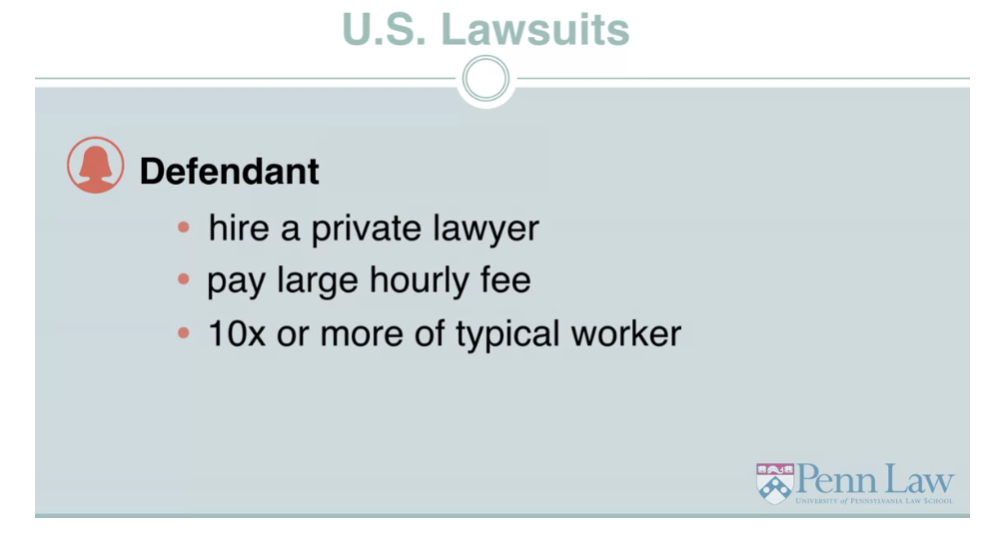
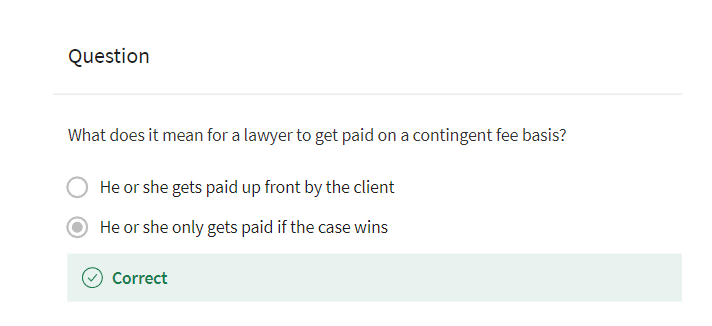
In the case of Brown versus Kendall,
Brown successfully convinced a judge and a jury, a jury made up of members of
his own community who were assigned to find the facts. He convinced them that he was truly
injured, truly injured by Kendall, and that the injury was the specific sort
the common law defines as a tort, a civil wrong. But Kendall did not consider
himself a tortfeasor, a wrongdoer. He considered the accident something for
which he should not be held responsible. He admitted his actions with the dogs and
the big stick, and that they contributed to the serious
injury that his friend suffered, but he believed he’d done nothing wrong. He had not wanted to wound the plaintiff. He’d only wanted to separate the dogs for the legitimate purpose of protecting
them from mutual destruction. Dogs can’t be allowed to hurt one another. For Americans, dogs are treasured. They can be pets and companions. They can be work animals that
help us earn our living. Back in the 1960s, my great-grandfather
used a pack of hound dogs that he kept underneath his house for
hunting and fishing. Dogs hunt and help put food on the table. Dogs can pull transportation sleds,
guard businesses and homes, and sniff out crimes. They can help blind people to
safely navigate city streets.
Kendall’s attorneys appealed a decision
against him to the Supreme Judicial Court of Massachusetts, and
in this higher court, he won. Kendall believed he’d acted lawfully
in trying to separate the dogs and that he had not been negligent
in the way he used the stick. Indeed, it could be argued that if
any one was negligent, it was Brown. Arguably, Brown was standing
carelessly close to Kendall and that’s why he got struck in the face. Since Kendall was intently
watching the dogs, Brown should have been intently
watching out for himself. An old common law rule called the
contributory negligence rule will prevent an adult whose carelessness helped to
cause an accident from recovering in a lawsuit for accidental injury.
在这个上下文中,“recovering” 的意思是指在法律诉讼中寻求赔偿或索赔。因此,这句话的意思是,一个成年人如果因为自己的疏忽而导致了事故,根据一个叫做“过失责任”的旧常法规则,他将无法在意外伤害的诉讼中获得赔偿。
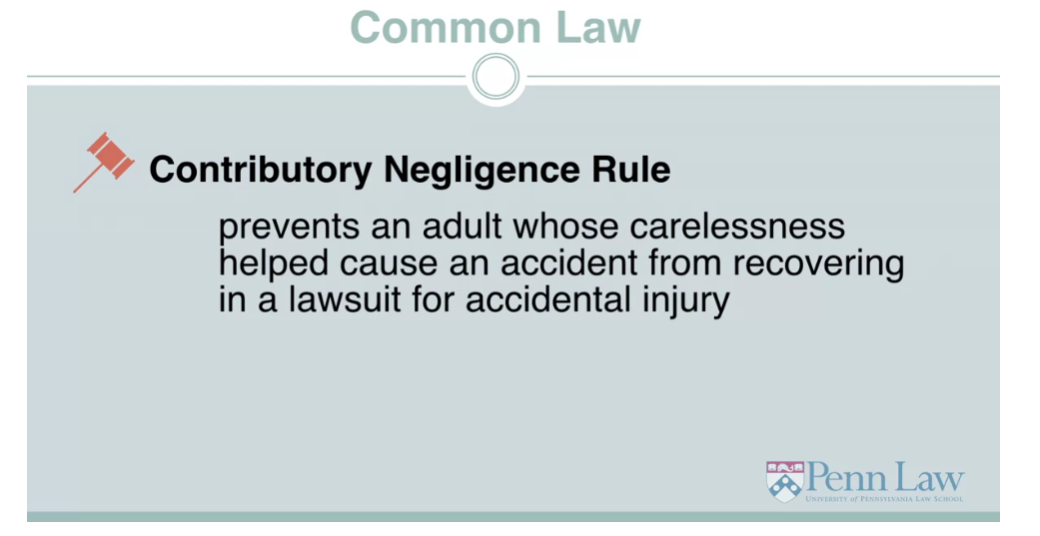
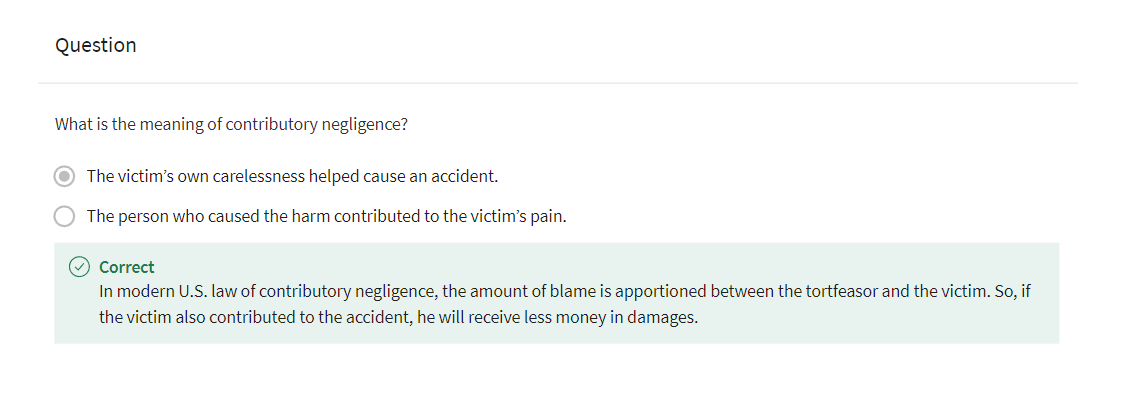
Now, today we compare the fault of those
but for whom the accident would not have occurred, and we apportion blame,
reducing by some percentage the amount a contributory negligent plaintiff
can recover in their lawsuit. Chief Judge Shaw ruled on appeal
that the trial court had not properly instructed the jury. The jury should have been told clearly
that Kendell would not be liable to Brown unless he’d injured him either
intentionally or negligently. Brown and his lawyers failed to
persuade Judge Shaw and the high court that the correct rule of American
common law was a rule of strict liability.
Under a rule of strict liability, if you
cause an injury by deliberate act, even if you don’t mean to do it, you’re liable
no matter how careful you may have been. Brown’s lawyers wanted the court
to follow, in essence, the logic of an ancient English
case sometimes thought to be evidence of a common law
rule of strict liability. This case is called the Case of Thorns. In the Case of Thorns, a man trimming
hedges on the property line between his land and his neighbor’s land crossed
over to clean up some fallen branches. He was found civilly liable for
trespass even though his intentions were kindly rather than
a deliberate effort to trample and destroy with force and
arms a neighbor’s land. He was trying to pick up his trash. Nonetheless, he trespassed and
was found liable.
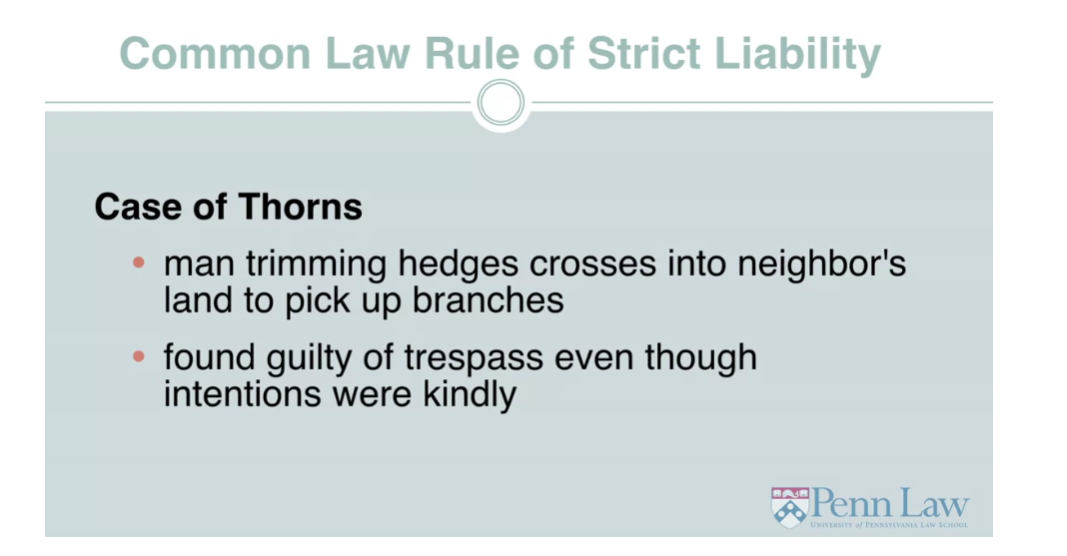
So, in the end, it was found
that Kendall would not have to pay Brown unless in the new trial
ordered by Judge Shaw, Brown could show that Kendall acted negligently or
intentionally in injuring him. [MUSIC]

Tort Law: Part 3
[MUSIC] Mr. Kendal’s victory before Chief Judge
Shaw happened more than 150 years ago. But it tells us something about American
tort law that remains true today. Brown vs Kendall pronounced that
America’s tort system is and should be a generally fault based system. If a man or
woman is to be found liable for an accident in a typical case,
it must be shown that they were at fault. He or she is at fault only
if they acted intentionally. We now say, “knowingly” or
“purposefully.”. . Or if they acted negligently. A negligent person is one who
acts without the ordinary care or prudence suitable for the circumstances. We say they also act as a reasonable
person of ordinary prudence. A reasonable person of ordinary prudence. Judge Shaw, and
influential state judges after him, rejected the strict liability
interpretations of the common law. A New York court bluntly rejected English
strict liability rules as unsuitable for a new world, nation building nation.
In the case of Losee vs Buchanan,
a boiler exploded in a paper mill, damaging adjacent property. The owner of the property went
to court to recover based on a strict liability theory. But the New York court, like the Massachusetts court, decided
that plaintiffs need to establish fault. The injured plaintiff had to
prove by a preponderance of the evidence that the owner of
the boiler either intended the harm, which he clearly did not, or
had been negligent, which was possible. It was not enough that his boiler
exploded, the question for the judge and jury is whether the boiler exploded as a
result of the negligence of it`s owner or his employees. Thanks to courts in Massachusetts and
in New York, liability for accidental injury is generally
based on a proof of negligence.
American scholars debate whether the rules
of negligence are more efficient or fair than rules of strict liability. Some legal historians claim
the Rule of Fault was embraced by the 19th Century judges,
because it was implicitly or explicitly thought to be helpful to
the cause of American Capitalism. The spirit of entrepreneurship and
innovation can fly freer if one doesn’t have to worry about being strictly liable
for inevitable, but unwanted accidents. It has been suggested that
the American rule of Law, our social contract promises
us security and freedom. Tort Liability,
based on the fault principle, arguably enhances our freedom,
while respecting our need for security. How so? Well, negligence liability disincentivizes
carelessness and unreasonable risk taking. Free enterprise,
an opportunity in theory open to all, exploits dangers with
supposed benefits for all. Trains are dangerous but
beneficial to the public. And so are factories, tall buildings,
bridges, chemicals, boilers, and dams. The price of utter safety would be
a lack of progress and productivity.
Now, is this truth, ideology. I’m not asking you to accept these
political economic assumptions. I merely report them as perspectives
voice in our courts that may help to explain a central feature
of American tort law. American tort law generally
requires that those who bring a civil lawsuit prove that the
person who injured them was at a fault. This is a distinctive though
debated feature of our law. Sometimes referred to as the fault system. In the case of fighting dogs, Brown vs Kendal one man
injured another accidentally. Under American tort law if this
accident was a result of negligence, there would be liability. However, if the accident
was not due to negligence, there would not be a liability.
根据美国侵权法,如果这起事故是疏忽造成的,就要承担责任。然而,如果事故不是由于疏忽造成的,则不存在赔偿责任。
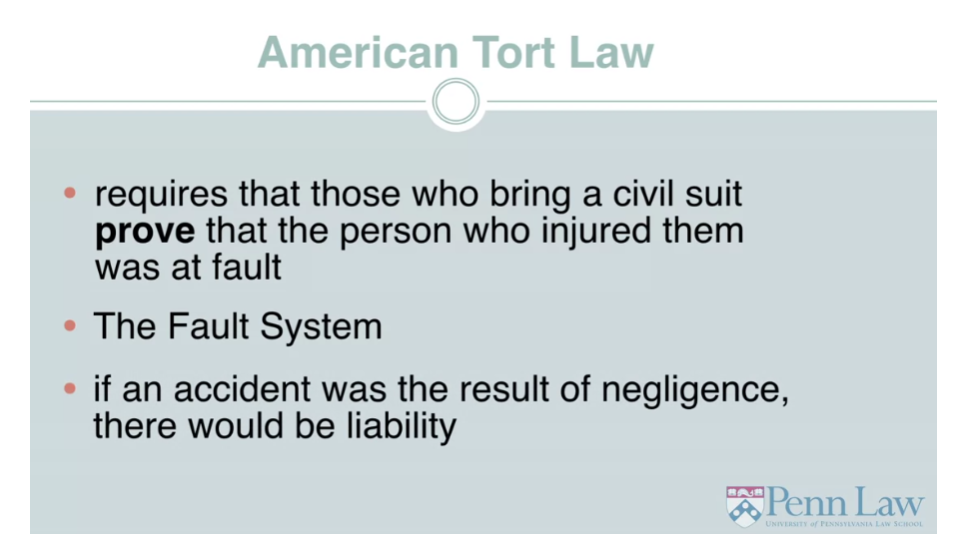
But what, exactly, is negligence? The contemporary definition of
negligence builds on the 19th century concept articulated by Judge Shaw. In contemporary tort law, negligence
is defined as a breach of duty of care owed to others, which causes injury
to a third person or a person’s property. The duty owed in most cases, the law says, is the duty of the reasonable person of
ordinary prudence under the circumstances.
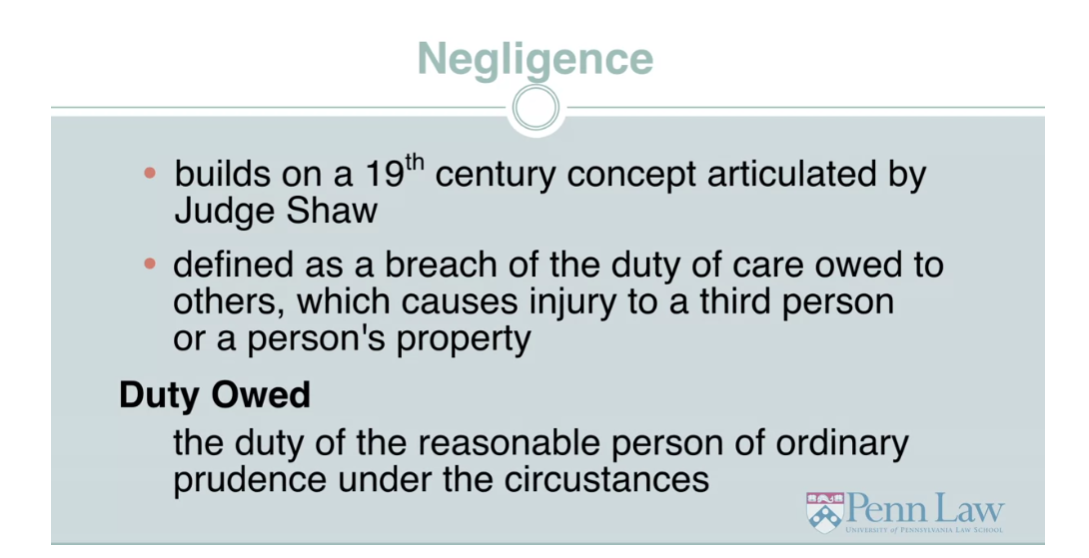
So American courts and legal experts suggest that the reasonable
person thinks about cost and benefits. If a small inexpensive expenditure of
care can avert a more expensive and probable injury,
that care should be undertaken. Arguably, beating dogs with a long
stick when one knows another man is standing close by, but
out of sight is negligent. To make swinging a stick more careful,
perhaps one should shout a warning. Watch out, stand back. The cost of that burden of care is far
less than the cost of forseeable injury to the man standing behind. [MUSIC]

Tort Law: Part 4
[MUSIC] The fault system recognizes negligence as
one kind of fault and intent as another. Let’s change the story. Suppose hypothetically that Mr.
Kendall was angry at Mr. Brown. He struck him in the face with
a stick on purpose, injuring his eye. Now he would be civilly liable not for
negligence, but for an intentional tort,
the tort called battery. Battery is defined as purposefully or
knowingly causing harmful or offensive contact with another.
殴打被定义为故意或故意与他人发生有害或冒犯性接触。
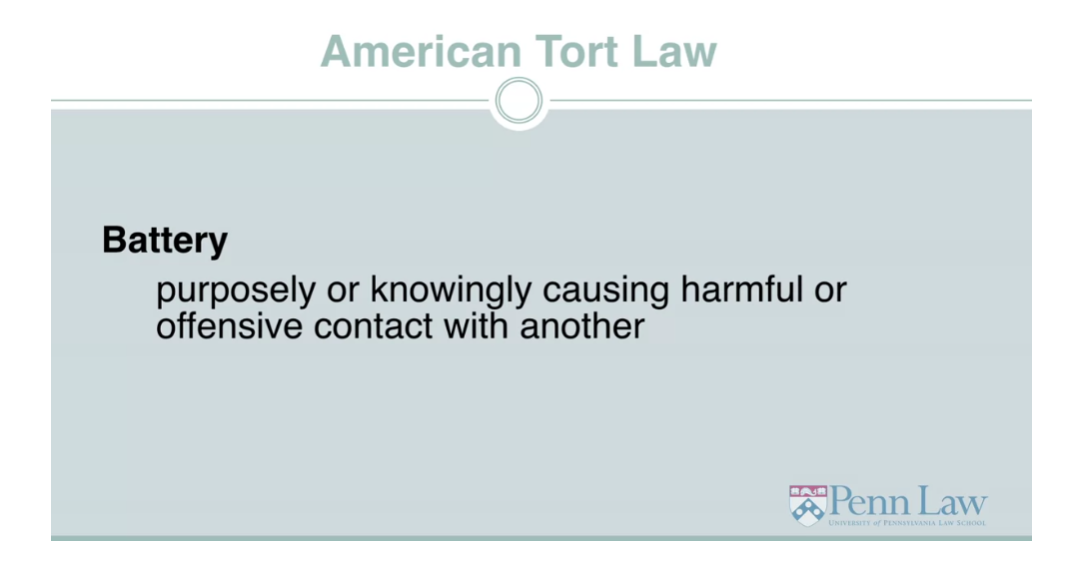
Kendall can be taken to court by Brown
if he negligently caused injury or if he intentionally caused an injury. By the way, and this is an important
point, some torts are also crimes. Battery is also a crime in American law. So if you hit someone on purpose or
stab them or shoot them, you can be prosecuted for a crime by the
public authorities and be fined or jailed. And on top of that, your victim can
sue you and recover money damages. If you steal from someone, you could
be prosecuted for theft as a crime, but also privately sued for the tort of
trespass to property or conversion.
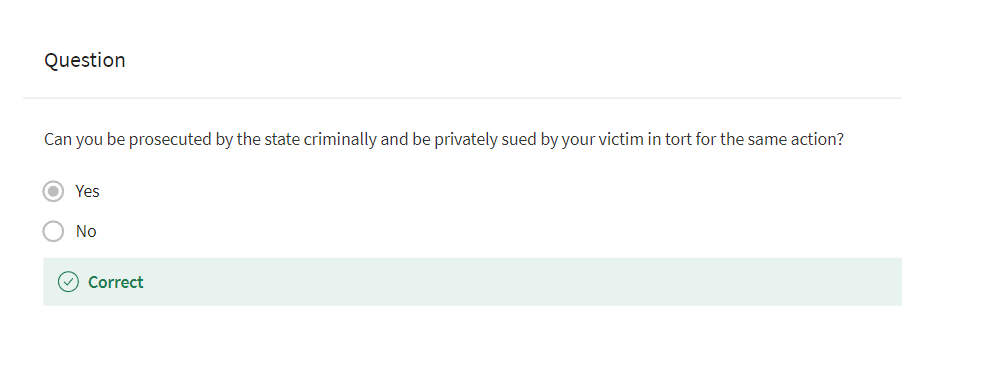
There are many intentional torts. Battery is only one. Assault is another, along with false
imprisonment, trespass to land and chattel, conversion or civil theft,
infliction of emotional distress, defamation, invasion of privacy,
interference with a contract, and a few others.
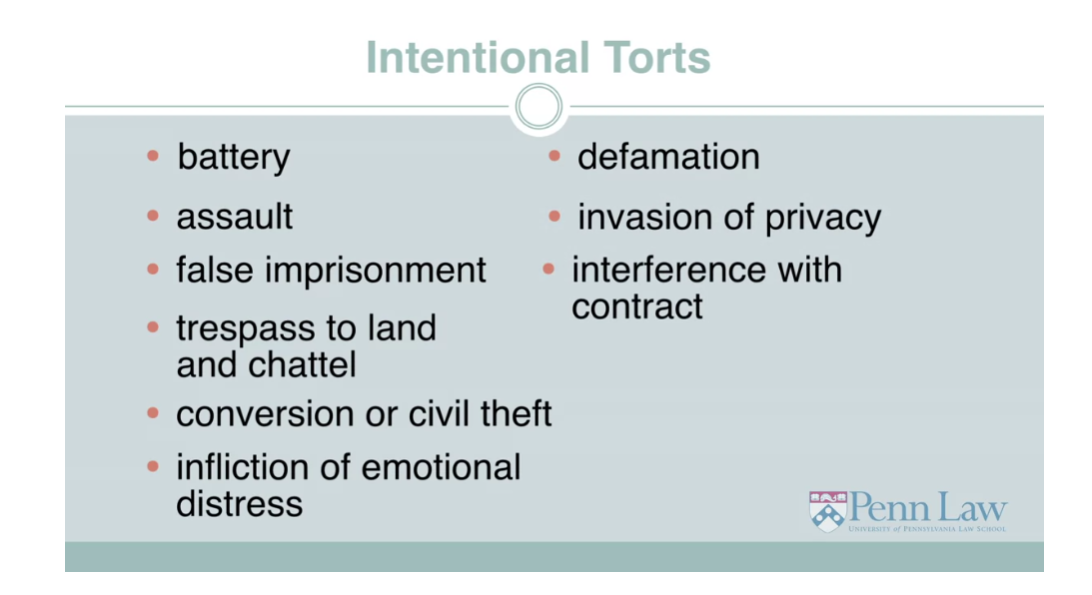
The list of intentional torts is finite,
and like all of tort law, subject to change. It used to be a tort to steal
the affection of a man’s wife or daughter. It no longer is in the age
of gender equality. Invasion of privacy was not a tort until
the courts began to recognize it in the early 20th century in response to
technology that made it possible for commercial photographers to use people’s
photographs without their permission.
The fault system allows for
defenses and excuses. With a good defense or excuse,
you can avoid tort liability even for intentionally harming somebody or
their property.
Let me introduce another true story, this one involving a case of
intentional injury from 1971. A woman and her husband, Mr. and Mrs. Briney,
owned a house inherited from her parents. The house was in a remote area and they preferred to live elsewhere, so they
boarded up the house, furnishings and all. Now, for many years,
whenever they would visit the house, they discovered that thieves had broken
in and stolen various household items. The husband got fed up. He decided he would address
the problem by setting up a shotgun trap in
the bedroom of the house. He wired up the gun such that opening the
door of the bedroom would cause the gun to go off and injure the lower body of
an adult-sized person in its path. Mr. Katko and a friend went to
the Brineys’ house to steal bottles and jars for their antique collection. They ignored a large no trespassing
sign posted outside the house. They broke in. When Katko opened the bedroom door, the spring-gun trap went off
just as Bernie had planned, and Katko was shot in the legs, causing severe
permanent injuries and deformities. Katko sued Mr. and Mrs. Briney for
battery, but they snapped back with a defense that has tempted many Americans,
defense of property. We have a right to defend our
property from thieves, they argued. The appeals court decided differently. Although property is important,
human life and limb is more important. If thieves threaten
a person in their home, use of a gun in self-defense
is often permissible. But use of a gun to protect property in
an unoccupied house is not justifiable. [MUSIC]
Tort Law: Part 5
[MUSIC] The fault system is not the whole story
of American tort law by any means. There are areas of tort law where a person
can be held liable for an injury, even though he or she has not been
negligent or intended harm or offense. Tort law includes doctrines
of strict liability. One might find this surprising in
light of Brown versus Kendall. If a fault-based system is so just and
practical, how can doctrines of strict liability, liability without fault,
also be just and practical? One way to understand
the situation is this. While generally speaking, American tort
law holds people liable when they are at fault, some activity is so dangerous
the law holds those who engage in it to a higher standard, a standard of
liability without regard to fault. The exception to the fault principle for very hazardous activities may
function to discourage it. Hence, the doctrine of strict liability
for injuries caused by the possession of wild animals and for
blasting operations as part of our law. If a person keeps dangerous wild animals,
say snakes, poisonous snakes, or adult chimpanzees in their home,
and the animal bites a guest, the animal’s keeper will be strictly
liable to the injured person. Or if a person is engaged in a business
involving the use of blasting or explosions he’ll be strictly liable for
resulting injuries there too.
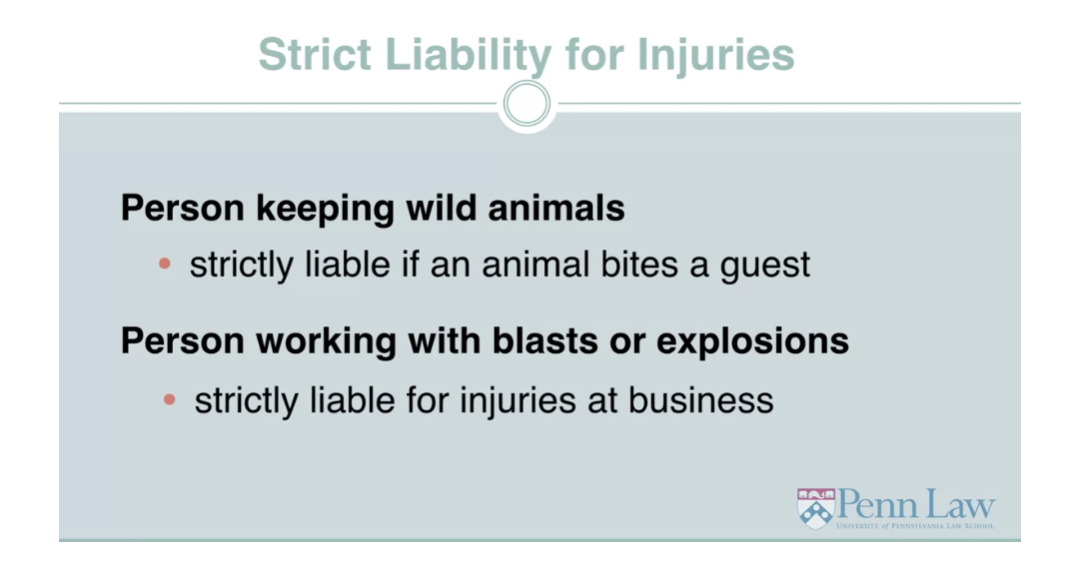
American tort law also
holds the manufacturers of consumer products strictly liable for
injuries caused by manufacturing defects. The argument for departing from
the fault principal here is different. It’s not so much that manufacturing
consumer products like make-up, or motorcycles, or
medicines is itself dangerous. It’s that the public has
expectations of safety and cannot protect themselves from risk and
dangers, of which they may not be aware. Some courts recognize
near strict liability for unreasonably dangerous product designs and
poor product labeling. Courts and commentators sometimes stress
that justice or good public policy of asking those who profit from enterprises
to internalize the true cost of their businesses to assume the burden
of redistributing injury cost through their insurance pricing and to seek the
optimal levels of investment in safety.

Even when liability is based on fault,
American tort law eases the burden of proving fault to make it easier for
plaintiffs to recover. Sometimes it’s not practical to
expect someone who’s been injured to prove exactly in what way they were
injured through negligence, and the injury itself strongly
suggests negligence.
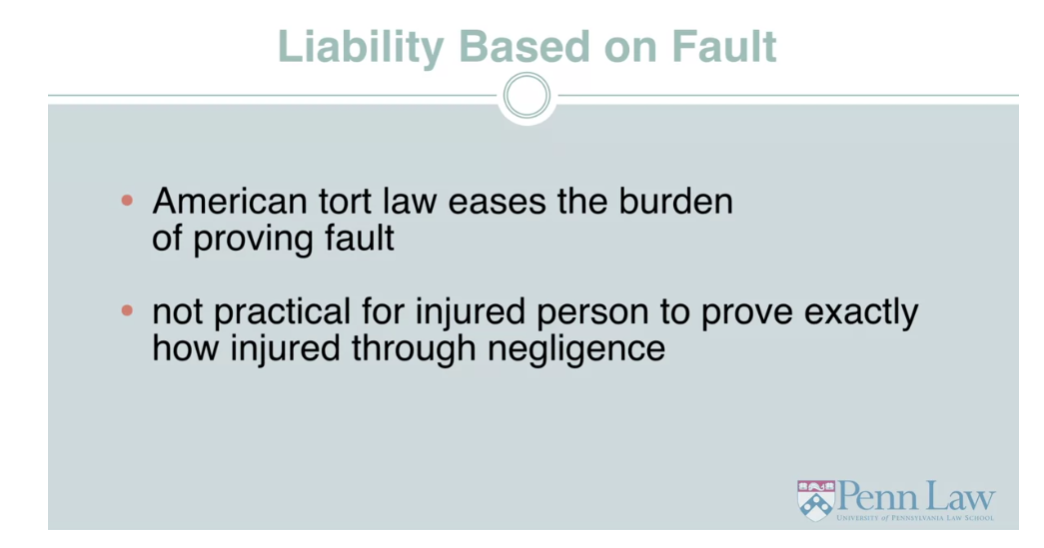
For example, if a barrel of flour
falls out of a second story window and hits a pedestrian on the head, doesn’t
that mean whomever was in control of the barrel of flour had
to have been negligent? Res ipsa loquitur we say,
the thing speaks for itself.
The Latin phrase res ipsa loquitur stands for the concept that although it is ordinarily the plaintiff’s burden to prove negligence, the defendant should carry the burden instead because the defendant controlled the situation or the instrument that caused the injury and the injury was of a kind that does not usually occur in the absence of negligence. 拉丁语中的 “因果关系”(res ipsa loquitur)代表这样一种概念,即尽管通常情况下原告有责任证明被告存在过失,但被告应承担举证责任,因为被告控制了造成伤害的情况或工具,而且伤害的类型通常不会在没有过失的情况下发生。
If a bottle of Coca-Cola explodes
in the hands of a waitress can we assume that that particular bottle
was negligently manufactured? If a patient wakes up from
abdominal surgery and his arm is paralyzed can’t we assume
that somebody in the operating room was negligent even though the patient who
was under anesthesia cannot prove it? Doesn’t the thing speak for itself?
Sometimes tort law makes one person
responsible for the wrongdoing of another. Employers, though faultless,
are liable for the negligence of workers that
takes place in the scope of duty. The pizza delivery guy employed by
Joe’s Pizza causes an accident while recklessly speeding to
make his next delivery. Let’s imagine. Well, Joe’s Pizza is vicariously liable,
respondeat superior, we say, more Latin.
So, American tort law is a system of
fault-based liability with several important exceptions. Tort law is not the only way in which
America deals with problems of injury. In most states,
automobile drivers are required to have no-fault insurance policies that pay for
personal injuries without regard to fault. Workers who get injured at work
due to the routine negligence of their employers are not permitted
to sue those employers. They must apply for
compensation through an insurance program, the worker’s compensation
insurance system. 由于雇主的日常疏忽而在工作中受伤的工人不允许起诉这些雇主。他们必须通过一个保险项目,即工人赔偿保险系统申请赔偿。
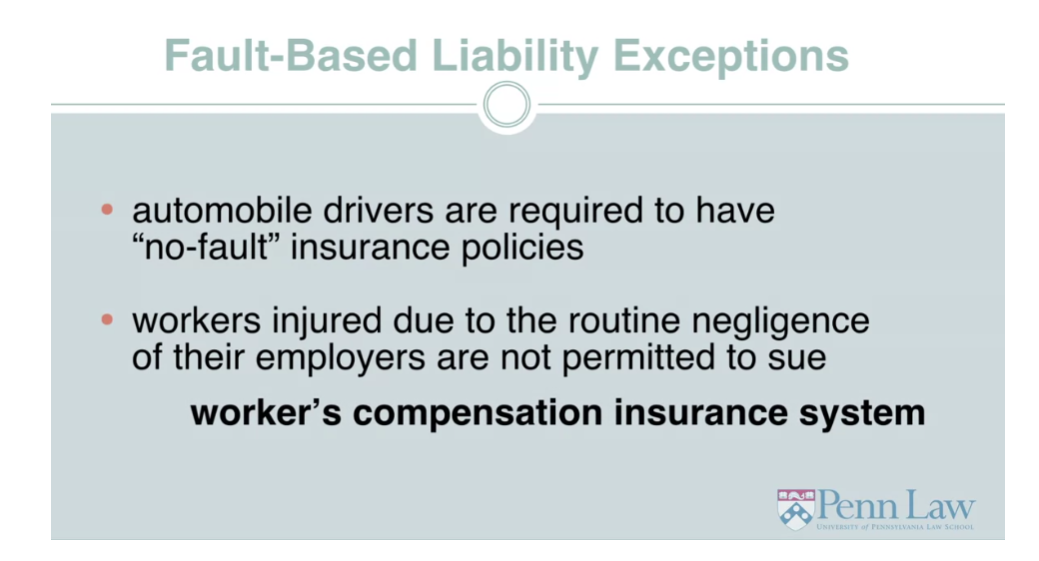
Various victim injury funds,
some ad hoc, some standing, compensate people injured by vaccines,
hurricanes, oil spills, and terrorism. Such funds heal nationally felt wounds and free the courts from a large number of
related but factually complex cases. In the case of vaccine compensation,
the tort alternative means that drug companies that make vaccine
need not fear liability for providing tools essential
to our public’s health. [MUSIC]
Tort Law: Part 6
[MUSIC] American Tort Law can be understood as a
principled system of fault based liability with some exceptions for dangerous
activities and consumer product defects. But as you learn the rules of Tort Law
in detail, it can look less and less principled. Like a Mish Mash of policy,
politics and pragmatism. Some doctrines seem harsh or unfair. The law allows civil suits against small
children, even as young as four or five years old. Mentally ill people
whose actions stem from serious psychiatric delusions
are liable for intentional acts. As between too innocent some courts say, the person who caused
the injury should pay. But why? The law recognizes liability for
highly offensive invasions of privacy and outrageously intentional inflictions
of emotional distress, but not for racial epithets and slurs. However, hatefully intended.
American Tort Law traditionally, has not required that we lend
a helping hand to people in danger. Unless we put them in the path
of danger ourselves or have a special relationship to them. So if I see a woman drowning in
a shallow pond, I’m not liable to her or her family if I simply let her drown,
even if I’m a strong swimmer and the law does not require me
to warn strangers of dangers. If I see a train coming and
notice a blind man on the track, I’m not obligated to warn the man of
the danger or pull him to safety.
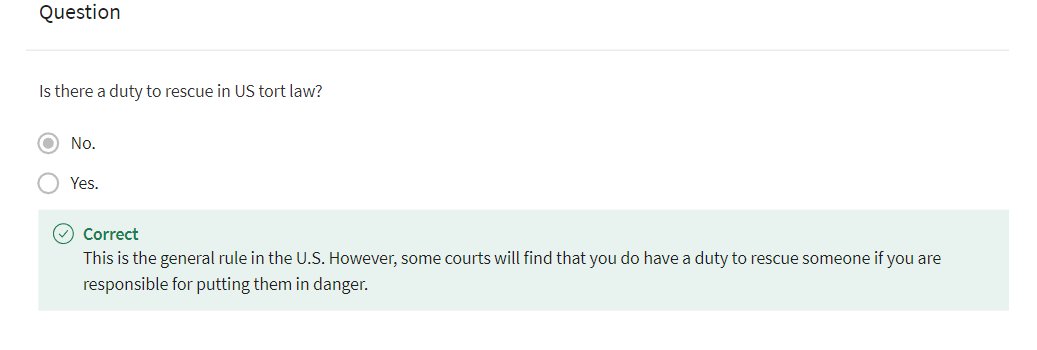
Lately, there’s been a trend in American
Common Law to expand the understanding of who owes a duty of care to whom. This is a positive trend in my view. Tort Law is becoming more generous. More compensation driven,
more strongly deterrent. Psychologists now have a duty
to warn potential victims of their mentally ill patients. Schools are responsible for
protecting children from harm. The government is responsible to
people they take into custody.
There’s also a trend in American Common
Law to hold businesses responsible for crimes caused by third parties. Suppose you’re out shopping and
get robbed and beaten up in the parking lot of a major
retail chain store like Wal-Mart. Even though your injuries were caused
by a criminal and not by Wal-Mart, a court might hold Wal-Mart responsible if
the store could have seen that a lack of security in the parking lot would
make customers vulnerable to crime.
But modern Tort Law is not
consistently compensation driven. Politics get in the way. It took many, many years for courts to
find that cigarette manufacturers were responsible for cancer,
death and disability. Even though gun violence is a major
problem in the United States, courts have not generally held gun
manufacturers tortuously responsible for criminal and accidental gun injuries
caused by other individuals.
This may be attributed to
the power of the gun lobby. The political climate of the United States
is highly relevant to Tort Law. Lobbyists for physicians have had an
impact on the creation of statutory caps on the amount of money that can be
recovered in a medical malpractice action. Lobbyists for manufacturers have had
an impact on the creation of caps on damage awards for pain and
suffering and punishment. Product liability laws make
it harder in some states for plaintiffs to prove a design defect. Whether the mix of pro business,
pro victim tort rules and policies serve the public
is a vital question. Distinguishable from the question of
whether they have good origins in politics and power.
Let me try to summarize and conclude. Americans believe that injuries caused
by others deserve a just response. Tort Law is widely presumed to be
a just response to the felt need for society to compensate,
to deter and to punish injury. Through its Tort Law,
American society empowers individuals. Injured through intentional,
negligent, and dangerous activities or the use of defective consumer products to
file civil complaints through the courts. Such complaints may seek financial
payments and other remedies from blameworthy private parties or
state, local and federal governments.
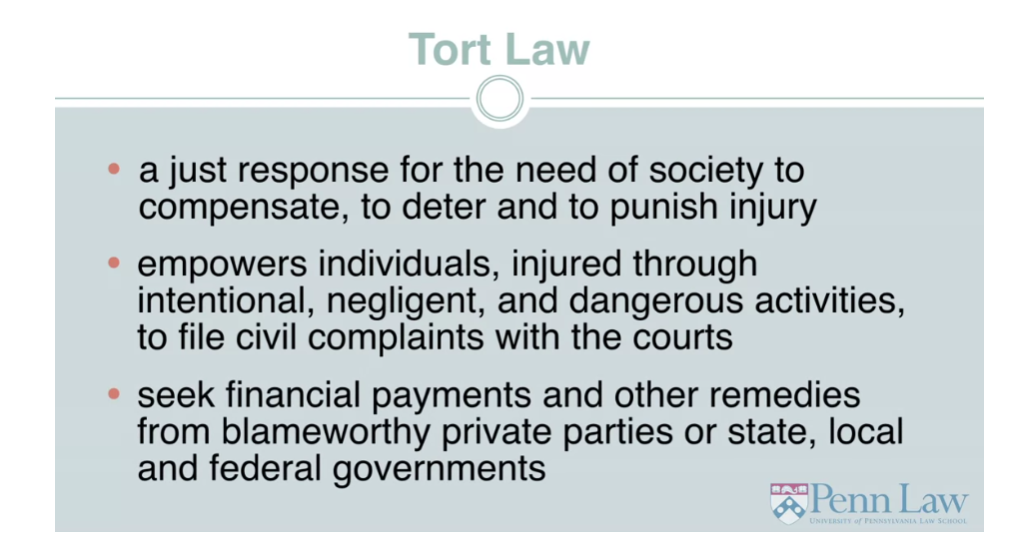
With a good lawyer guiding them and a
strong enough claim, an injured man, woman or child can secure a certain kind of
justice, the satisfaction of the claim in a courtroom before a judge and jury or
in a negotiated out of court settlement.
The Tort Law fault system is one
of the means to which our rule of law secures freedom and security. We are free to engage in a wide,
wide range of conduct subject only to the demand that we not hurt
others intentionally or negligently. If we do, justice demands that we
restore them to their status quo ante to the position they were
in before the injury we caused. We cannot bring back their vision or their
ability to walk without a painful limp, but we pay them a sum of money
that a judge and jury believes. Fairly compensates them and
deters them and others.
The fault system is motivated
philosophically by the goals of compensation and deterrence. We want people to be made
whole when they’re hurt and someone else has been at fault,
it’s only fair. But we also want there to be
fewer instances of injury. We want a safer world. We want to create incentives for
safety and restraint. And so we impose toward liability to increase the odds that people
who can behave differently do.
The fault system is also motivated
by the goal of punishment, though that is mainly
the job of the criminal law. If people are very malicious and reckless,
the civil courts may award money damages called punitive damages to punish and
very strongly deter future wrong doing by the defendants and others who don’t
want to suffer the same fate. Some activities are so dangerous, we assign liability
responsible parties not at fault. And because of dangers to
consumers of defective products, we impose strict liability and modified versions of strict liability
in negligence rules to assign blame. The trend of holding third parties
responsible for crimes and recognizing special relationships
as the basis of duties to warn and rescue, reflects that compensating people
for injury is increasingly seen as more important than freeing people
from the burden of payment.
Finally, we have discovered
that Tort Law is not an adequate response
to the problem of injury. Some victims of injury are cared for through private,
no-fault insurance managed by the state. Workers compensation,
managed by the state. Or special victims’ funds,
some managed by government. The Common Law of Torts is old law and
it’s new law. From time to time,
there are demands for Tort reform. From time to time,
there are Tort reforms by statute. But the wisdom of Common Law, the wisdom of our Common Law judges is
the foundation of American Tort Law. This law is as relevant as ever. It’s workable and
welcome when it evolves as we evolve. Thank you. [MUSIC]
这段内容总结了美国侵权法(American Tort Law)的一些核心概念和趋势。以下是一些主要观点:
侵权法的性质:美国的侵权法是一个以过错为基础的责任制度,但也存在一些对危险活动和消费品缺陷的例外情况。
法律的混杂性:尽管侵权法被认为是一个原则性的制度,但随着深入了解,人们可能会发现它看起来更像是一种杂糅了政策、政治和实用主义的混合体。
责任扩展的趋势:最近,美国普通法的一个趋势是扩大谁对谁负有关心责任的理解,这是一个积极的趋势,使得侵权法变得更加慷慨、更加注重赔偿,并且更加强烈地具有威慑作用。
政治和法律的关系:政治因素对侵权法产生影响,例如医生和制造商的游说活动可能会影响法院制定赔偿限制等政策。
责任和赔偿:侵权法的目标之一是通过赔偿和制裁来对待伤害,因此,对造成损害的人进行赔偿既是公平的,也是一种威慑行为的手段。
严格责任:对于一些极度危险的活动或者消费品缺陷,法律会赋予严格责任,即使责任方没有过错也会被追究责任。
私人保险和政府基金:一些伤害受害者可能通过私人无过错保险、工伤赔偿或政府管理的特别受害者基金来获得赔偿。
法律的发展和改革:尽管侵权法是一个古老的法律制度,但随着社会的变化,它也在不断发展和改革,而普通法法官的智慧是侵权法的基石。
这些观点共同构成了对美国侵权法的理解和反思,强调了其作为一种法律制度在赔偿、制裁和预防伤害方面的重要作用。
This segment summarizes the content of a course on American Tort Law, highlighting key concepts and trends:
Nature of Tort Law: American Tort Law is described as a fault-based liability system, with exceptions for dangerous activities and consumer product defects.
Complexity of the Law: Despite being viewed as principled, Tort Law can appear less so upon detailed examination, often seeming like a mixture of policy, politics, and pragmatism.
Trends in Liability: There’s a recent trend in American Common Law to expand the understanding of duty of care, making Tort Law more compensation-driven and deterrent-focused.
Influence of Politics: Political factors influence Tort Law, such as lobbying by physicians and manufacturers affecting statutory caps and damage awards.
Responsibility and Compensation: Tort Law aims to provide just responses to injuries through compensation and deterrence, reflecting a philosophical motivation for fairness.
Strict Liability: In cases involving highly dangerous activities or defective products, strict liability is imposed, holding parties responsible regardless of fault.
Private Insurance and Government Funds: Some injury victims may be compensated through private insurance, workers’ compensation, or government-managed funds.
Legal Development and Reform: Tort Law evolves with societal changes, with occasional calls for reform, often enacted through statutes while recognizing the wisdom of Common Law judges.
These points collectively illustrate an understanding and critique of American Tort Law, emphasizing its role in compensation, deterrence, and addressing societal needs.
Tort Law Quiz
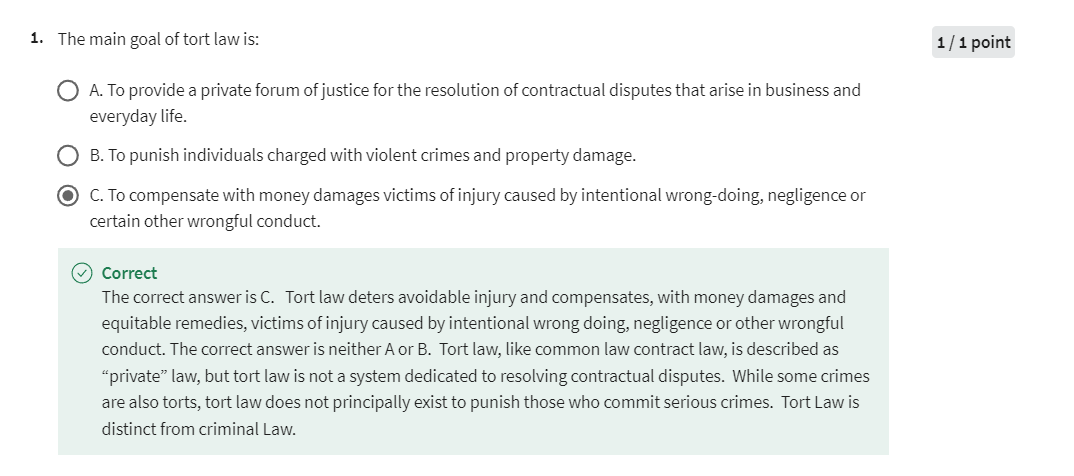
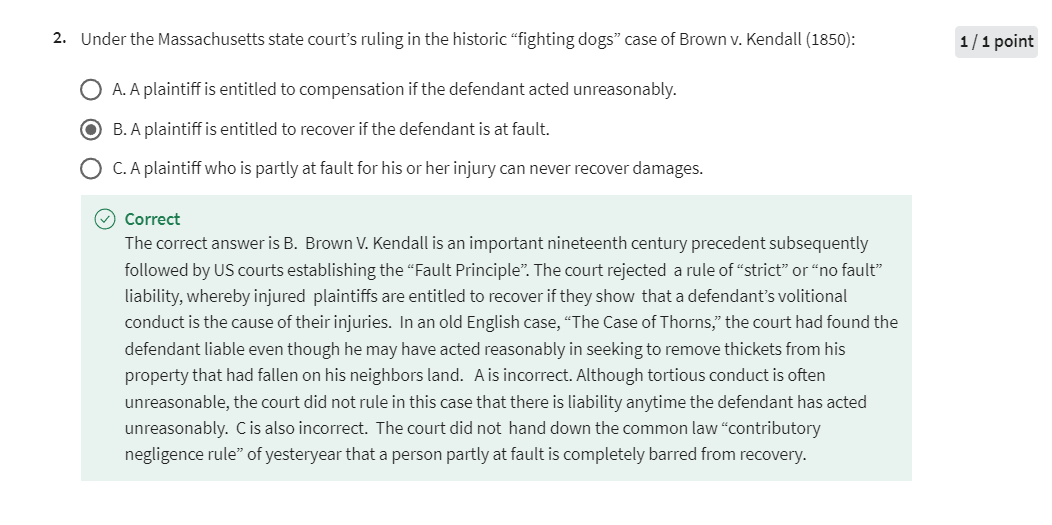
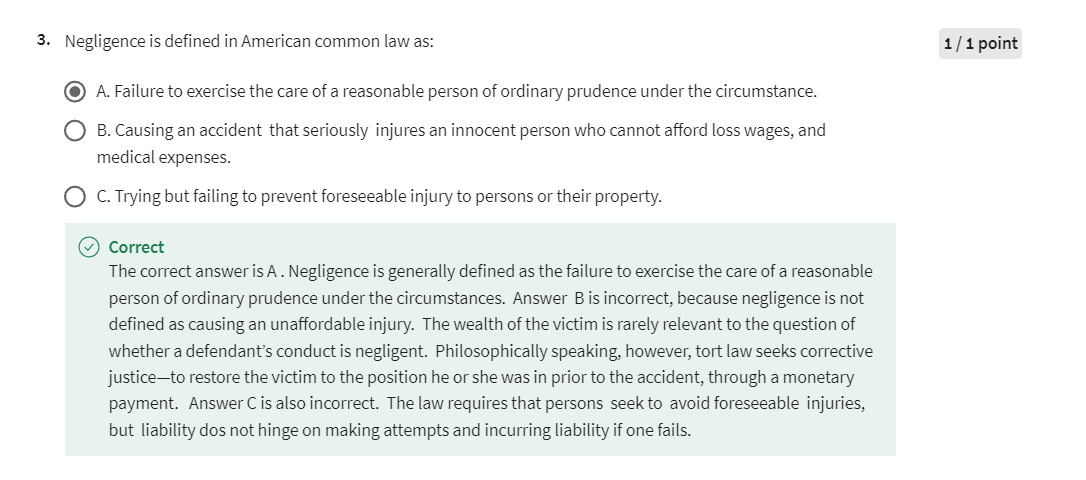
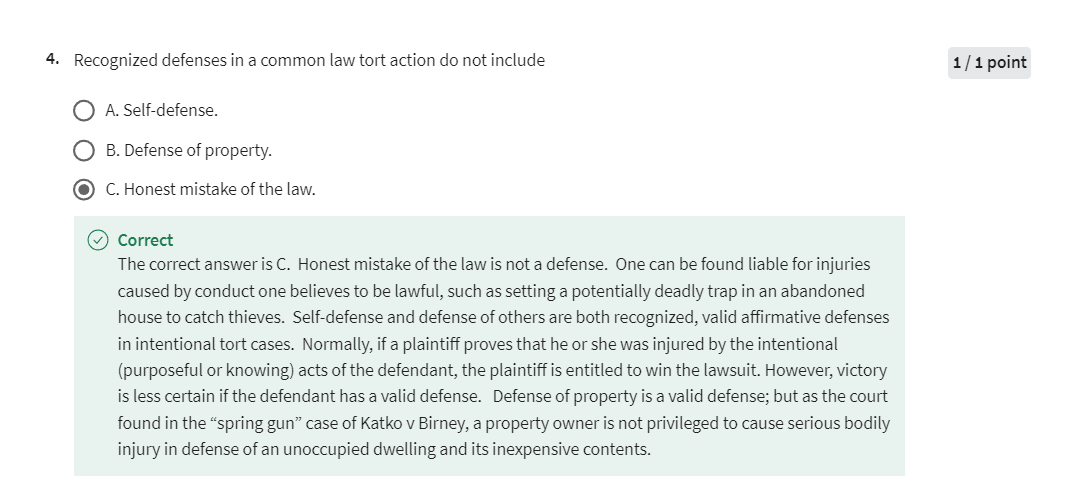
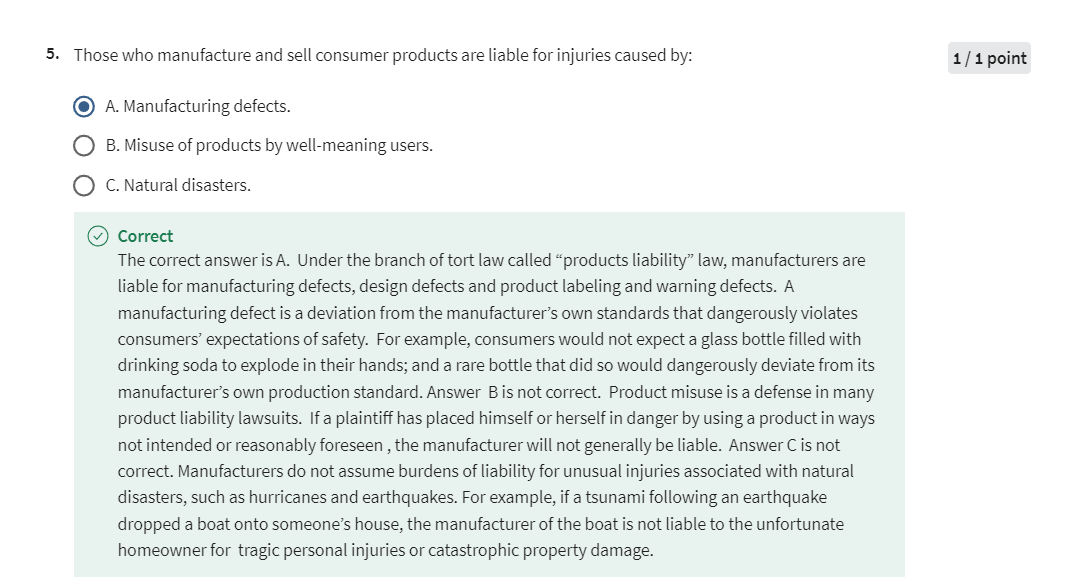
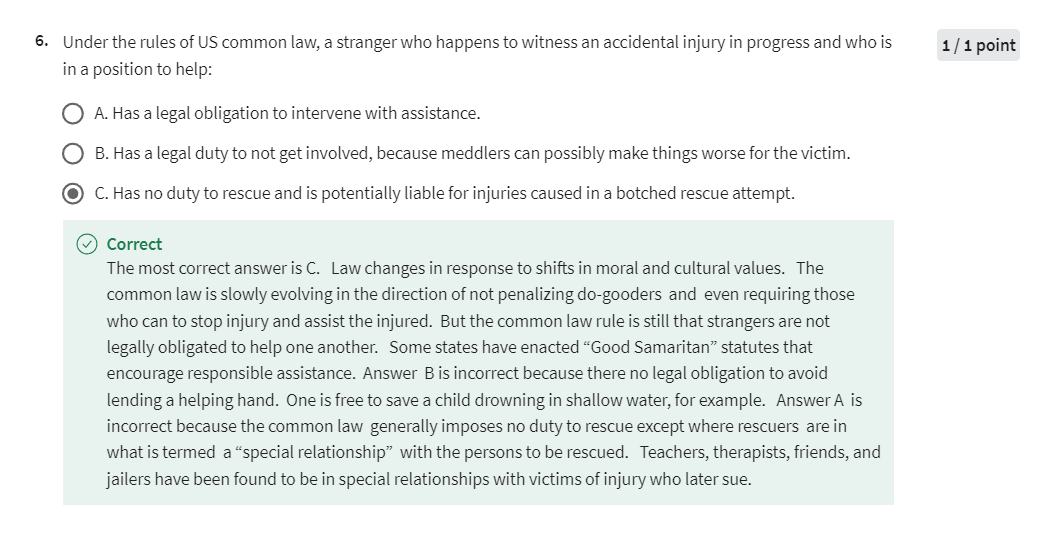
法律英文
lawsuit: 美 [ˈlɔːsuːt] 诉讼
civil lawsuit: 民事诉讼
adjudicate:美 [əˈdʒudəˌkeɪt] 判决,裁决,宣判
adjudicating private disputes:裁决私人纠纷
adversary system of procedural justice:程序正义的对抗制
state statutes:州的法规
redress: 美 [rɪˈdres] 矫正,补救,纠正
[动词+名词短语] (formal)纠正;矫正;改正
to correct sth that is unfair or wrong
同义词:put right
to redress an injustice纠正不公
malice: 美/ˈmælɪs/ 恶意,怨恨
commonality:共性,共同特征
calamity:美/kəˈlæməti/ 灾难,灾祸
plaintiff: 美 [ˈpleɪntɪf] 原告
defendant:美 [dɪˈfendənt] 被告
sue:美 [suː] 控告;对(人;机构)提起诉讼;
getting sued:被起诉
litigious:美 [ləˈtɪdʒəs] 诉讼的,好打官司的,可诉讼的
with deep pockets:财大气粗
hassle:美 [ˈhæsl] 麻烦,打扰,争论
attorney:美 [əˈtɜːrni] 代理人,律师
contingent fee:胜诉酬金;成功酬金;
civil wrong:民事过失
tortfeasor:美 [ˈtɔrtˌfizər] 侵权犯
wrongdoer:美 [ˈrɔŋduə®] 做坏事的人;违法犯罪者;作恶者
sled:雪橇
sniff out:发现,嗅出
Dogs can pull transportation sleds, guard businesses and homes, and sniff out crimes. 狗可以拉运输雪橇,守卫企业和家园,并嗅出犯罪。
Supreme Judicial Court of Massachusetts:马萨诸塞州最高法院
contributory negligence:共同过失;与有过失
apportion blame:分摊责任
recover:“recovering” 的意思是指在法律诉讼中寻求赔偿或索赔
trial court:初审法院
Chief Judge Shaw ruled on appeal that the trial court had not properly instructed the jury. 首席法官肖在上诉中裁定,初审法院没有适当地指示陪审团。
在这句话中,“on appeal” 意味着某人(在这种情况下是首席法官肖)对之前的法院裁决进行上诉或者进行了上诉审查。这意味着首席法官肖对法院之前作出的裁决进行了审查,并做出了裁决,认为之前的法院没有正确地向陪审团提供指示。
be liable to:应负责的;应承担责任的;
intentionally or negligently:故意地或者不是故意地
The jury should have been told clearly that Kendell would not be liable to Brown unless he’d injured him either intentionally or negligently. 陪审团应该被清楚地告知,肯德尔不会对布朗负责,除非他故意或过失伤害了他。
Brown’s lawyers wanted the court to follow, in essence, the logic of an ancient English case sometimes thought to be evidence of a common law rule of strict liability. 布朗的律师希望法庭从本质上遵循一个古老的英国案例的逻辑,该案例有时被认为是严格责任的普通法规则的证据。
property line:地界线
trim hedge:修剪树篱
a man trimming hedges on the property line between his land and his neighbor’s land crossed over to clean up some fallen branches 一名男子在他的土地和邻居的土地之间的地界线上修剪树篱,清理一些掉落的树枝
trepass:擅闯某人地界;侵犯某人财产;冒犯;触犯;
trample:美 [ˈtræmpl] 踩;践踏;无视;藐视
He was found civilly liable for trespass even though his intentions were kindly rather than a deliberate effort to trample and destroy with force and arms a neighbor’s land. 尽管他的意图是善意的,而不是故意用武力和武器践踏和破坏邻居的土地,但他被判对非法侵入负有民事责任。
intentionally = knowingly = purposefully 故意地
prudence:美 [ˈpruːdns] 谨慎
A negligent person is one who acts without the ordinary care or prudence suitable for the circumstances 疏忽大意的人是指行为时不注意或不谨慎的人
paper mill:造纸厂
adjacent:美 [əˈdʒeɪsnt] 邻近的,毗邻的, 注意发音
In the case of Losee vs Buchanan, a boiler exploded in a paper mill, damaging adjacent property. 在洛西诉布坎南案中,一家造纸厂的锅炉爆炸,损坏了附近的财产。
decided that plaintiffs need to establish fault. 在这里,“establish” 的意思是证明或确认。句子的意思是法官决定原告需要证明过失。
preponderance:美/prɪˈpɑːndərəns/ 优势,多数,总体
a preponderance of:大量的
The injured plaintiff had to prove by a preponderance of the evidence 受伤的原告不得不以大量证据进行证明
freer:free的比较级形式
The spirit of entrepreneurship and innovation can fly freer if one doesn’t have to worry about being strictly liable for inevitable, but unwanted accidents.如果一个人不必担心对不可避免但不必要的事故承担严格责任,那么创业和创新的精神就可以更自由地飞翔。
disincentivize:美 [ˌdɪsɪnˈsentɪvaɪz] 使(人;做法)失去激励;使泄气
negligence liability disincentivizes carelessness and unreasonable risk taking. 疏忽责任抑制了粗心大意和不合理的风险承担。
ideology:美 [ˌaɪdiˈɑːlədʒi]思想;思想体系;观念学;
This is a distinctive though debated feature of our law. 这是我们法律中一个颇具特色但备受争议的特征。
contemporary :美 [kənˈtempəreri] 当代的
breach of duty:失职,违反职责
negligence is defined as a breach of duty of care owed to others, which causes injury to a third person or a person’s property. 疏忽被定义为违反对他人的注意义务,对第三人或他人财产造成伤害。
expenditure:美 [ɪkˈspendɪtʃər] 花费,支出
avert:美 [əˈvɜːrt] 转移,避免
If a small inexpensive expenditure of care can avert a more expensive and probable injury, that care should be undertaken. 如果花费很少的关心费用可以避免更昂贵和可能的伤害,就应该进行关心。
forseeable :美 [fɔ’siəbl] 可预见的
stab:美 [stæb] 用xxx刺伤,戳
prosecute:美 [ˈprɑːsɪkjuːt] 对(某人;机构)提起公诉;告发;检控;
So if you hit someone on purpose or stab them or shoot them, you can be prosecuted for a crime by the public authorities and be fined or jailed. 因此,如果你故意打人、刺伤或开枪,你可能会被公共当局起诉犯罪,并被罚款或监禁。
And on top of that, your victim can sue you and recover money damages. 除此之外,你的受害者可以起诉你并要求赔偿损失。
Battery : 无故殴打
false imprisonment: 非法监禁
chattel:美 [ˈtʃædl] 个人财产,动产
infliction:美 [ɪnˈflɪkʃən] 强加,施加
defamation:美 [ˌdɛfəˈmeʃən] 中伤,诽谤
conversion:非法挪用
There are many intentional torts. Battery is only one. Assault is another, along with false imprisonment, trespass to land and chattel, conversion or civil theft, infliction of emotional distress, defamation, invasion of privacy, interference with a contract, and a few others. 有许多故意侵权行为。无故殴打只是其中之一。人身攻击是另一个问题,此外还有非法监禁、非法侵入土地和动产、非法挪用或民事盗窃、施加精神痛苦、诽谤、侵犯隐私、干涉合同以及其他一些问题。
tort liability:侵权责任
The fault system allows for defenses and excuses. With a good defense or excuse, you can avoid tort liability even for intentionally harming somebody or their property. 过错制度允许辩护和辩解。有了好的辩护或辩解,即使是故意伤害他人或其财产,你也可以避免承担侵权责任。
antique:美 [ænˈtiːk] 古董,古玩 antique collection 古董收藏
justifiable:美 [ˌdʒʌstɪˈfaɪəbl] 正当或合理的;情有可原的;无可非议的;能辩护的
hazardous:美 [ˈhæzərdəs] 冒险的,危险的
commentator:时事评论员;时事评论家;实况播音员;解说员
abdominal:美 [æbˈdɑːmɪnl] 腹部的
paralyze:美 [ˈpærəlaɪz] 使麻痹;使瘫痪
vicariously:美 [vɪ’keərɪrslɪ] 代理地;担任代理者地;间接感受到地
vaccine:美 [vækˈsiːn] 疫苗
psychiatric:美 [ˌsaɪkiˈætrɪk] 精神病的;精神病学的;
delusion:美 [dɪˈluːʒn] 错觉,妄想
psychiatric delusions:精神妄想
outrageous:美 [aʊtˈreɪdʒəs] 肆无忌惮的;毫无节制的;难以容忍的;大胆的;不寻常的;
slur:美 [slɜːr] 诋毁,诽谤
epithet:美 [ˈepɪθet] 绰号;侮辱性称谓
racial epithets and slurs:种族蔑称和诽谤。
drown:美 [draʊn] 淹死,溺死
pond:池塘
drowning in a shallow pond:在浅池塘中溺水
deterrent:美 [dɪˈtɜːrənt],有威慑力的,能起到威慑作用的
More compensation driven, more strongly deterrent. 更多的赔偿驱动,更强的威慑力。
custody:美 [ˈkʌstədi] 监护,拘留
[protective custody](javascript:void(0)😉
保护性拘留
[youth custody centre](javascript:void(0)😉
青少年罪犯羁押所
[in custody](javascript:void(0)😉
在羁押中;拘留中;在押
tortuously:美 [tɔtjuəsli] 转弯抹角地,弯曲地
Even though gun violence is a major problem in the United States, courts have not generally held gun manufacturers tortuously responsible for criminal and accidental gun injuries caused by other individuals. 尽管枪支暴力是美国的一个主要问题,但法院通常不会认定枪支制造商对其他人造成的刑事和意外枪支伤害负有侵权责任。
deter:制止,防止,威慑住
mish mash:大杂烩
lobby:游说团体
lobbyist:游说者
physician:医生
medical malpractice action:医疗事故诉讼,
medical malpractice: 医疗事故;医疗责任事故;医疗失职
statutory caps:法定上限
This may be attributed to the power of the gun lobby. The political climate of the United States is highly relevant to Tort Law. Lobbyists for physicians have had an impact on the creation of statutory caps on the amount of money that can be recovered in a medical malpractice action. 这可能要归功于枪支游说团体的力量。美国的政治气候与侵权法高度相关。医生的游说者对医疗事故诉讼中赔偿金额的法定上限产生了影响。
The fault system is motivated philosophically by the goals of compensation and deterrence. 过失制度是由补偿和威慑的目标从哲学上驱动的。
punitive:美/ˈpjuːnətɪv/ 惩罚性的;处罚的;刑罚的
punitive damages:惩罚性赔偿
后记
2024年4月24日15点03分完成week1: Tort Law的学习。